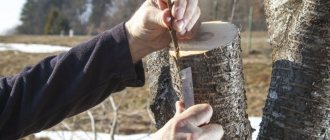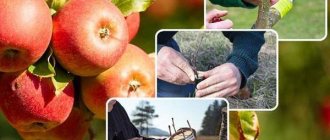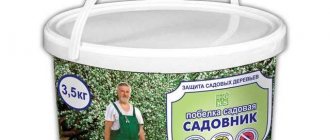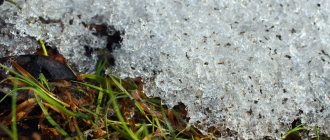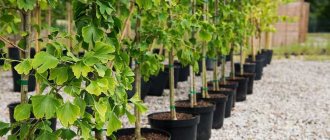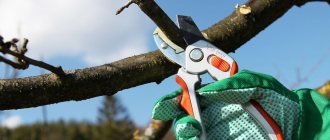Are you interested in growing several varieties of apples, pears, and mulberries on one tree? Do you want to rejuvenate your orchard and grow new varieties on old plants? If this is the case, then you should learn how to graft fruit trees. In general, there are a lot of ways. That’s why some people don’t do this, because they think that it’s a very difficult task and beyond the capabilities of an ordinary summer resident. But if you are not afraid to experiment, you can quickly get the hang of it, and then grafting fruit trees will happen without problems for you.
First, let's look at the method that is described in the book “Smart Garden in Detail,” and after that you can watch a video about grafting trees in the spring from the TV show “The Bed,” or vice versa: first watch the video and then read the article. Let us mention right away that when we talk about the timing and time of vaccination, we mean the end of February - the first half of March.
What is vaccination
Grafting is the joining of two parts of different plants, as a result of which they grow together and continue to grow as a single plant. The part of the plant that is grafted is called the scion, and the plant onto which it is grafted is called the rootstock.
Spring grafting is the most effective way to propagate varietal plants. Having mastered the skill of grafting, we will be able to:
- replenish the garden with new varieties and replace old, uninteresting ones;
- grow non-winter-hardy varieties on a frost-resistant trunk;
- collect a collection of different varieties on one tree;
- grow a garden on poorly suited soils, using rootstocks with the desired characteristics;
- turn ordinary bush plants into original ones with an atypical shape (standard roses, currants, gooseberries, etc.);
- save the tree after damage.
How to choose a rootstock
The rootstock cutting is selected so that it is compatible with the grafted variety. This is the foundation of the future tree on which the cuttings of the cultivated variety will develop. The development and fruiting, as well as the taste characteristics of the fruit, depend on the correctly selected rootstock.
The rootstock can be a broken tree that has retained its vitality, a stump with good roots, or a wild species of a related tree. The cutting takes root well on a tree that is more than two or three years old. It has a developed root system that supplies nutrition to the petiole grafted onto it.
When to do it?
In the spring, grafting trees with cuttings (copulation) is done during active sap flow, when plant tissues grow together best. This period begins around the second ten days of April.
Mandatory condition: for grafting cuttings, take annual shoots with dormant buds.
Therefore, we prepare cuttings in advance, perhaps at the beginning of winter, and store them, wrapped in film, in the cold until spring. When harvesting, we cut the cuttings from the illuminated side of the crown - they ripen better there.
Preparing for work
To graft trees you need to prepare:
- grafting (copulating) knife;
- annual shoots harvested at the beginning of winter (November-December) - cuttings, which were stored in a damp state at t0-3C;
Cuttings for grafting
- rootstocks (what you will graft onto - these can be either specially grown seedlings or just individual branches on large trees);
- film for strapping;
Grafting film
- Garden varnish to protect grafts from drying out.
Before grafting, cuttings can be soaked in water. Garden varnish is sold ready-made in garden stores. But you can cook it yourself. To do this, take 6 parts of paraffin, melt it and mix it with three parts of crushed rosin. Add 2 parts of vegetable oil (or mineral oil) to the mixture brought to a boil. Let simmer for 10 minutes. Then the pitch is kneaded and put into jars
A special film is produced for vaccinations. It is elastic, tightly fixes the grafting site and prevents it from drying out. The special film can be replaced with insulating tape or strips of polyethylene.
The grafting knife must be sharpened so that it can cut the hair on the hand.
How to graft trees?
N. Kurdyumov suggests, in his opinion, the simplest way to graft trees in the spring - into the stump of a trunk up to 5 years old for the bark, and if the tree is 5 or more years old, then into the stump of a branch for the bark.
For the operation itself, we will need black vinyl electrical tape or any other electrical tape, a small and very sharp knife, and garden pitch.
When should trees be grafted? It is advisable to do this when the buds bloom on the rootstock (+/- 2 weeks), before the leaves appear. The scion cutting itself must still be in the dormant phase, so that it does not bloom ahead of time and dry out the scion.
Spring grafting of fruit trees
In the spring, during sap flow, vaccination is performed using the following methods:
- copulation (simple and improved);
- into the side cut;
- for the bark.
Copulation grafting (compounding) is used when the scion and rootstock are of the same thickness. There are simple and improved copulation.
With simple copying
- On the cutting (scion) and on the rootstock, oblique cuts of the same length are made (the length of the cuts should be 3-4 times greater than the diameter of the branch).
Simple copulation
- Place the scion and rootstock tightly with cuts to each other (there should be no gaps)
- The junction is tightly tied with film tape. You need to be careful - if the sections are displaced, fusion will be poor
The disadvantage of this method is that the connection is very unstable, so another, improved option is often used.
Improved copulation
It differs in that splits are made with a knife on the sections of the scion and rootstock. The location of such splits is 1/3 of the distance from the upper (sharp) end of the cut. The depth of the split is almost to the beginning of the oblique cut. Combine the sections so that the splits fit into each other. The cuts must match completely.
Improved copulation
If the scion and rootstock are not the same in thickness, then it is necessary that the layers of bark on one and the other part of the grafted elements coincide on at least one side. In these layers of bark or cambium there is a layer of cells “responsible” for the strength of the graft connection.
Wrapping the graft with film
Immediately after combining the scion with the rootstock, the junction is tightly wrapped with film and coated with garden varnish.
Grafting "Into the lateral cut"
If there is a large difference in the thickness of the rootstock and scion, the “lateral cut” grafting method is used. This method is quite easy and is often used by gardeners.
Lateral incision grafting
To execute it you need to do the following:
- cut the rootstock (fruit tree seedling) 10-20 cm above the intended grafting site
- make a longitudinal oblique cut on it 2-2.5 cm long and at an angle of 20-25 degrees
- sharpen the end of the cutting with a wedge also 2-2.5 cm long
- insert the cutting (bud side out) into the cut, trying to connect the bark on both parts
- Tie the grafting site with film tape
Vaccination “For the bark”
If you need to re-graft thick branches in the spring, while sap is flowing, use the “bark” grafting method. Such grafting works best on apple, pear, plum, and cherry plum trees.
How it's done:
- The branch on which you decide to graft is cut at a right angle, the end is cleaned
- On the grafted cutting (it should have 3-4 buds), an oblique cut is made under the bud and the bark is cut off a little on the sides of the cut.
- The bark of the rootstock is cut longitudinally down to the wood.
- Unfold the strip of bark on the rootstock and insert the cutting so that the cut of the cutting protrudes above the cut of the branch by 1 cm (in this case, the fusion will be with an “influx”, which will increase the strength of the graft).
Vaccination for bark
- Tied with film and coated with garden varnish
Why do this
First of all, you need to know what a vaccination is. Tree grafting is the grafting of parts of one plant onto the stems of another. And the plants to whose stems grafting occurs are called rootstocks. As a result, a complex plant will grow on your site, the roots of which will belong to the rootstock, and the rest, including the crown of the tree, will belong to the scion.
The photo shows a diagram of grafting garden trees
Why do you need to do this? As a rule, rootstocks regulate the functioning of the root system; it develops well and gives the correct pace to the development of the plant. And the scion is able to preserve all the best qualities of the plant, its decorative and nutritional function.
What the tools for grafting fruit trees look like is indicated in the article.
To get a good harvest, it is important to achieve high-quality fusion of trees. It is necessary that the vascular system of one tree become related to the vascular system of another. This is usually achieved by grafting plants related to each other. For example, the Apple tree genus, the Cherry genus. Sometimes families close to each other are vaccinated.
But most often they are faced with the fact that plants of the same family go through the merging process very poorly. Sometimes grafting does not occur at all. If the process is successful, it will not last long. Why is this happening? Most likely, the plants in this case are simply incompatible with each other.
The video shows how to graft fruit trees:
Reasons for incompatibility
- Genetics. Genetic distance most often plays a big role.
- The second follows from genetic distance. Grafted plants differ in their rates of development and growth.
Experts say that even within the same genus, certain plants cannot be grafted. For example, it will not be possible to graft a winter apple tree onto a summer apple tree. The same applies to the Cherry genus. Scientists to this day continue to study the question of why some plants cannot be grafted onto others. But we can say for sure that it will not be possible to grow pears or cherries on an apple tree. Why is vaccination done in general?
- The process of fruiting of especially valuable plant varieties is accelerated . Often a grafted tree begins to bear fruit much earlier than usual.
- Unadapted but very good plants are propagated . Often some southern crops are grafted, which give a good harvest.
- Space saving . A summer resident can grow several varieties on one tree. For example, several varieties of this plant can be grown on one pear.
The video shows cuttings for grafting fruit trees:
Procedure time
It is believed that the best time to vaccinate is summer and spring. The day for grafting should be cloudy, but without rain. As for the time of day, here you can choose any time. Many summer residents say that the most successful grafting of plants occurs in the spring.
As soon as spring comes, the procedure can be carried out on plums and cherries. These plants are frost-resistant and are not afraid of cold weather. It is better to plant apple or pear trees when the air temperature becomes stable.
As soon as you see the first buds on the trees, you can begin. If the climate in your area is dry and warm, then cuttings can be grown even in summer. Gardeners often use the lunar calendar to choose the most suitable day for this procedure.
What varieties of tomato seeds for polycarbonate greenhouses are most often used are indicated in the article.
How tomatoes are gartered in a polycarbonate greenhouse can be seen in the video in this article.
What is the technology for growing tomato seedlings can be found in the article here: //gidfermer.com/sadovodstvo/ovoshhevodstvo/rassada/vyrashhivanie-rassady-tomatov-v-domashnix-usloviyax.html
Whether it is necessary to soak tomato seeds before planting is indicated in the article.
In autumn, plants are not grafted due to low temperatures. Such conditions do not allow the plant to take root. But if you need to plant in the fall, do it early, when the weather is good and the days are warm.
Winter was considered the time of year when it was not worthwhile to plant a plant. But now scientists are proving the opposite. It is now believed that vaccination in winter is a new step in development. Some gardeners have already tried grafting in the winter.
Many got good results. Cherry plum, pear, cherry, and apple trees usually provide good planting material. As a result, you can get a very good harvest. It has been observed that some plants have 100% survival rate under these conditions. Winter grafting differs from others in the following way: the cutting is able to grow in a short period of time.
Timing of grafting of trees of various species in your garden
In spring, grafting of fruit trees lasts throughout April and May, and apple and pear trees can be grafted until mid-June. Stone fruit crops, such as cherries, sweet cherries, plums, and apricots, are best planted in April-May. The best grafting method for stone fruits is improved copulation.
Plants obtained by grafting are more productive and enter the fruiting period much earlier than their own roots.
By learning how to graft, we can significantly expand the varietal diversity of our garden and get unusual trees with the properties we need.
Choosing a rootstock and scion
The success of the procedure depends on the choice of rootstock and scion. A good rootstock on which a new crop will be grafted must be resistant to disease. Pay attention to its location and check the fertility of the soil. For grafting, it is better to choose low-wind areas of the crown that are well illuminated by the sun.
As for the scion, fruit cuttings are mainly used for grafting, and less often, buds. To ensure survival, choose proven combinations of varieties. For example, graft new resistant varieties of domestic apple onto a domestic apple tree. If you already have experience with successful grafting, you can experiment and graft a pear onto a rowan or a plum onto an apricot.
The correct scion is prepared at the beginning of winter, but this can be done later. The main thing is that the buds on the cuttings have not yet swelled, and that it is at rest. It is best to store the prepared cuttings in the basement or refrigerator.
For cherries, cherries, plums and other stone fruits, choose long and thick branches that do not have many buds. Cut the cuttings into a couple of buds longer, because the lateral buds are often flowery and do not form new shoots.
Plant budding
Budding is the most common method of grafting fruit plants. This is due to the fact that its implementation requires a minimum amount of time and also does not require serious financial expenditure.
The procedure is performed strictly within the range of the sap flow period. The exact date depends on regional climate conditions, but is usually around the end of July.
For budding you will need seedlings whose branches are no more than 1 cm thick . The first step is to prepare the tree for grafting. It is necessary to get rid of all branches at the bottom of the plant. About 6-8 skeletal branches should be left in the crown, directed in different directions.
The scion will be one-year-old shoots that are at the initial stage of growth. They should have strong wood and buds formed. Cuttings no longer than 15 cm are harvested from their middle part.
After this, it is necessary to cut out small shields from wood about 3 cm in size. They are installed on the rootstocks. At the latter, a T-shaped cut of the bark is made, behind which the scutes are driven. Next, they need to be tied.
After a week and a half, you can check the result. If the budding was successful, you can see how the scion has taken root to the plant.

